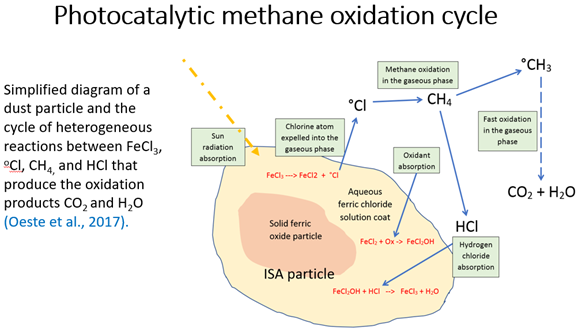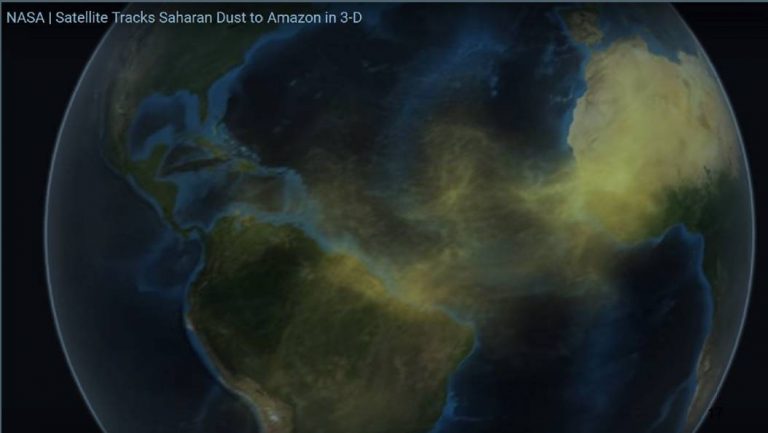Enhanced Atmospheric Methane Oxidation (EAMO)
The process to get rid of methane we already know. We burn it, or more scientifically speaking, we oxidise it. Now we will look at this process on a molecular basis:
1 CH4 + 2 O2 => 1 CO2 + 2 H2O
1 methane molecule plus 2 oxygen molecules turn into 1 CO2 molecule plus 2 water molecules.
But how can we burn it?
To oxidise methane in the atmosphere nature uses the power of the sun, UV light. The sun provides the energy to initiate the process. An additional requirement is the presence of a catalyser. One catalyser, which is present in the atmosphere, is Iron Salt Aerosol (ISA –chemical formula: FeCl3), it is a photo-catalyser. It helps the oxidation to happen, but it does not oxidise itself. This is good news because it is not consumed by the process, and can trigger it again and again… All ISA needs to do this is the sun shining.

Methane was always around and nature always got rid of it. From the beginning of times nature used ISA and other catalysers to remove methane, it is a natural process. Natural ISA is created by sand storms which lift Fe2O3 (iron-oxide (5) / rust) into the air. The rust reacts with salt (NaCl), which is always present above the ocean, to form ISA.

Mankind has more than doubled the atmospheric methane content, within the last 150 years, from 0.7 ppm to 1.9 ppm. Nature needs around 12 years on average to remove methane (6). We keep adding and adding and nature cannot cope – so, what can we do?
Firstly we can reduce our methane emissions. World leaders of 100 countries have signed an agreement – the global methane pledge – at COP26 in September 2021 in Glasgow, which promises to reduce anthropogenic methane emissions by 30% until 2050. According to scientific research even 54% are possible (16). But all agree, that it will not be possible to reduce all anthropogenic methane emissions to zero. Biogenic emissions, again, are hardly avoidable. Therefore a huge tasks remains: Remove half of man-made methane from the atmosphere.
We can assist nature to remove methane. We are the ones who caused all the additional methane to get into the air, so it is our task to help nature get rid of it. The best way to do this is by avoiding anthropogenic methane. In the COP26 in Glasgow world leaders decided to cut methane emissions by 30%, That’s good, but it is not sufficient. We have to remove methane from the air, by adding more ISA into the atmosphere.
ISA is a natural component of the atmosphere, like methane and CO2. However, unlike those gases, ISA is an aerosol, solid particles suspended in the air. ISA particles are so small, that they can remain airborne for several weeks before sinking down into the ocean or onto the land.
EAMO means adding ISA to the atmosphere. Half of anthropogenic methane is ~200 MegaTons per year which we should remove with EAMO. This would stop the current growth of atmospheric methane and would even make that methane content shrink, if slowly. Within ~20 years the methane content would sink to pre-industrial levels. The average global temperature would be cooled by ~0.5 °C, compared to what we would get without EAMO and without emission reductions (15).
Continue to Abe MR dispersion technology

